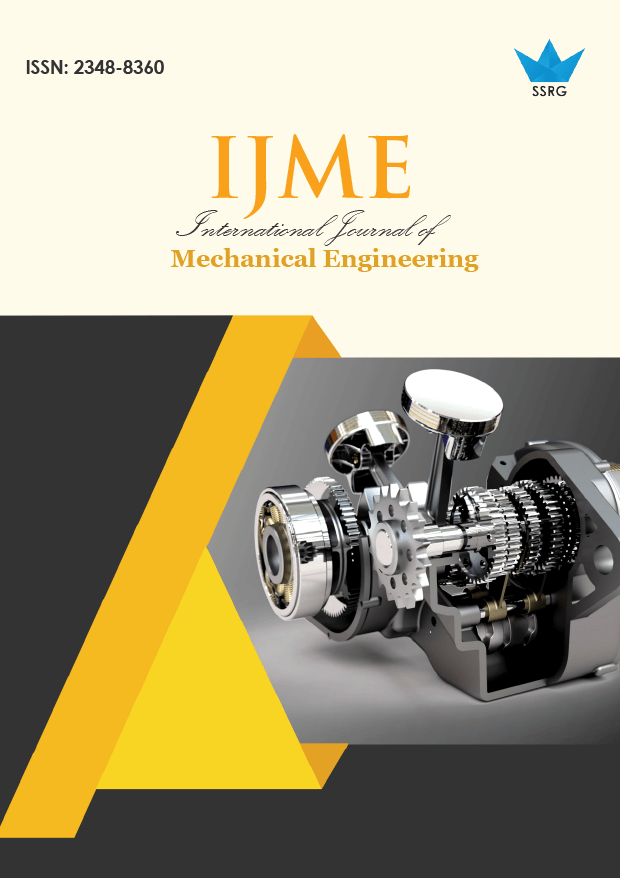Optimization Analysis of Ship Windlass Drum Based on RSM

| International Journal of Mechanical Engineering |
| © 2025 by SSRG - IJME Journal |
| Volume 12 Issue 8 |
| Year of Publication : 2025 |
| Authors : Xiaoyu Liu, Aldrin Calderon, Ruichen Tian |
How to Cite?
Xiaoyu Liu, Aldrin Calderon, Ruichen Tian, "Optimization Analysis of Ship Windlass Drum Based on RSM," SSRG International Journal of Mechanical Engineering, vol. 12, no. 8, pp. 20-27, 2025. Crossref, https://doi.org/10.14445/23488360/IJME-V12I8P103
Abstract:
This paper focuses on the optimization analysis of the winch drum in a ship anchoring machine using the Response Surface Method (RSM). A detailed analysis of its working principle and force conditions is conducted. Based on this, a high-accuracy finite element model is established in ANSYS Workbench. RSM is then applied to construct objective and surrogate models, enabling the exploration of the relationship between design variables and performance metrics. Through optimization, the stress distribution is significantly improved, the maximum equivalent stress is reduced, and material utilization is enhanced. These improvements contribute to the structural reliability and efficiency of the anchoring system, offering valuable guidance for engineering applications.
Keywords:
Winch drum of marine anchoring machines, Optimization analysis, Modelling analysis, Response surface methodology.
References:
[1] Yonghong Fan, Daoping Han, and Na Li, “Dynamic Response and Lightweight Design of Winding Drum Based on CAE Technology,” Journal of Vibroengineering, vol. 27, no. 4, pp. 694-708, 2025.
[Google Scholar] [Publisher Link]
[2] LBS. [Online]. Available: https://www.winchlbs.com/
[3] Hualong Yang, Xuefei Ma, and Yuwei Xing, “Trends in CO2 Emissions from China-Oriented International Marine Transportation Activities and Policy Implications,” Energies, vol. 10, no. 7, pp. 1-17, 2017.
[CrossRef] [Google Scholar] [Publisher Link]
[4] Shuwei Zhu et al., “Research Progress on Intelligent Optimization Techniques for Energy-Efficient Design of Ship Hull Forms,” Journal of Membrane Computing, vol. 6, pp. 318-334, 2024.
[CrossRef] [Google Scholar] [Publisher Link]
[5] Shihao Liu, Yanbin Du, and Mao Lin, “Study on Lightweight Structural Optimization Design System for Gantry Machine Tool,” Concurrent Engineering, vol. 27, no. 2, pp. 170-185, 2019.
[CrossRef] [Google Scholar] [Publisher Link]
[6] Wen Xian Tang et al., “Study on Modular Design in The Anchor and Windlass,” Advanced Materials Research, vol. 479-481, pp. 1722-1727, 2012.
[CrossRef] [Google Scholar] [Publisher Link]
[7] C. Hohmann et al., “Contact Analysis for Drum Brakes and Disk Brakes Using ADINA,” Computers & Structures, vol. 72, no. 1-3, pp. 185-198, 1999.
[CrossRef] [Google Scholar] [Publisher Link]
[8] S. Palani et al., “Stability Analysis of Self-propelled Aerial Man Lift Vehicles,” International Journal of Vehicle Structures and Systems, vol. 9, no. 5, pp. 276-279, 2017.
[CrossRef] [Google Scholar] [Publisher Link]
[9] Florian Vlădulescu, and Dan Mihai Constantinescu, “Lattice Topology Homogenization and Crack Propagation through Finite Element Analyses,” Procedia Structural Integrity, vol. 28, pp. 637-647, 2020.
[CrossRef] [Google Scholar] [Publisher Link]
[10] Alexander Zemliak, and Jorge Espinosa-Garcia, “Analysis of the Structure of Different Optimization Strategies,” COMPEL-The International Journal for Computation and Mathematics in Electrical and Electronic Engineering, vol. 39, no. 3, pp. 583-593, 2020.
[CrossRef] [Google Scholar] [Publisher Link]
[11] M.J. Garcia, and C.A. Gonzalez, “Shape Optimisation of Continuum Structures via Evolution Strategies and Fixed Grid Finite Element Analysis,” Structural and Multidisciplinary Optimization, vol. 26, pp. 92-98, 2004.
[CrossRef] [Google Scholar] [Publisher Link]
[12] Mohamed Slim Abbes et al., “An Acoustic–Structural Interaction Modelling for the Evaluation of a Gearbox-Radiated Noise,” International Journal of Mechanical Sciences, vol. 50, no. 3, pp. 569-577, 2008.
[CrossRef] [Google Scholar] [Publisher Link]

 10.14445/23488360/IJME-V12I8P103
10.14445/23488360/IJME-V12I8P103